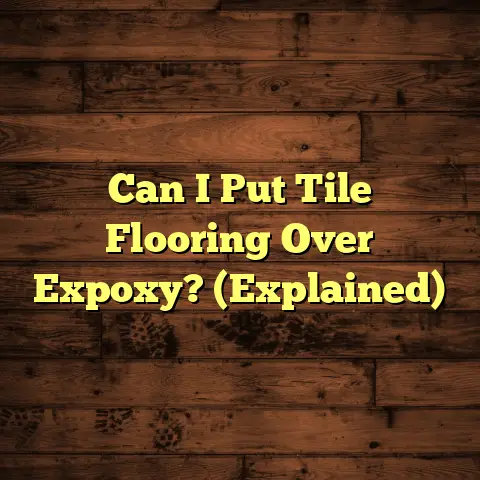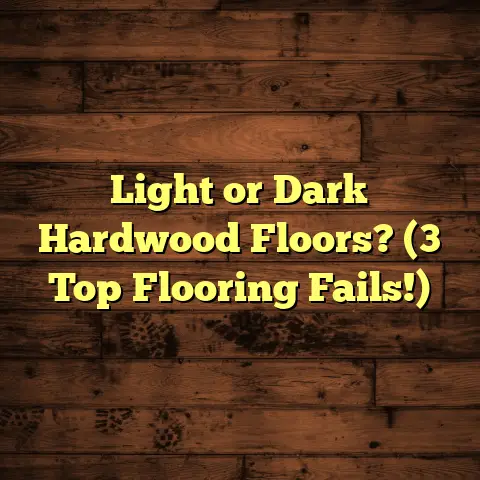Fix Squeaky Floors With Lube? (Don’t Try This!)
Ugh, squeaky floors! We’ve all been there, right?
That eeek… creak… groan that seems to follow you around the house, announcing your every move.
It’s enough to drive anyone bonkers. I’ve seen homeowners try everything to silence those pesky sounds. And I mean everything.
One “solution” that keeps popping up? Lubricant. Yes, like WD-40, grease, or even silicone spray. The idea is that it’ll ease the friction between the floorboards.
But trust me, as a flooring contractor with years in the trenches, grabbing that can of lube is a really bad idea.
Let’s dive into why, and I’ll show you the right way to tackle those squeaks.
1. The Allure of Squeaky Floors
1.1 Define Squeaky Floors
So, what are squeaky floors, exactly? It’s all about friction. That annoying sound is the result of two surfaces rubbing together.
Think of it like this: when you rub your hands together, you can feel the friction and hear a slight sound, right? Now, imagine that happening constantly under your feet.
With floors, that friction usually happens between:
- Floorboards and subfloor: The main culprit!
- Nails and wood: Loose nails rubbing against
the wood around them. - Floorboards and joists: Joists are the
horizontal beams that support your subfloor. - Adjacent floorboards: When boards are too
close together.
The type of flooring matters, too. Hardwood is a classic squeaker, but laminate and engineered wood can also develop squeaks over time.
Why? Because they’re all susceptible to movement, expansion, and contraction due to changes in humidity and temperature.
1.2 The Psychological Impact
Okay, let’s be real. Squeaky floors aren’t just an annoyance; they can mess with your head!
I’ve had clients tell me they feel like they’re living in a haunted house.
Every step is a potential soundtrack of creaks and groans.
Think about it:
- Stress: Constantly anticipating the next
squeak can be surprisingly stressful. - Privacy: Forget sneaking around for a
midnight snack! - Embarrassment: Guests over? Prepare for
your floors to announce their arrival.
One homeowner I worked with confessed that she started avoiding certain areas of her house just to avoid the squeaks. That’s no way to live!
1.3 The Cultural Context
Here’s a funny thing: squeaky floors have a weird place in our cultural imagination.
In movies and books, they’re often portrayed as charming, nostalgic, even romantic. Think of an old Victorian house with “character.”
But in real life? Not so charming.
They might evoke a sense of history or tradition, but the reality of living with them day in and day out is far from idyllic.
It’s like that old saying: “The squeaky wheel gets the grease.” Except in this case, the grease is a terrible idea! (More on that later.)
2. The Unique Material – Lubricants
2.1 Introduction to Lubricants
Alright, let’s talk about lubricants.
What are they? Simply put, they’re substances that reduce friction between surfaces.
Think of oil in your car engine. It keeps everything running smoothly and prevents parts from grinding against each other.
There are tons of different types of lubricants, each with its own properties:
- Oil-based: Classic lubricants, often used
for machinery. - Water-based: Good for applications where
flammability is a concern. - Silicone-based: Resistant to high
temperatures and often used in automotive. - Grease: Thicker than oil, used for heavy-
duty applications.
2.2 The Chemistry Behind Lubrication
The science behind lubrication is pretty cool.
It’s all about viscosity, which is a measure of a fluid’s resistance to flow.
A lubricant with the right viscosity creates a thin film between two surfaces, preventing them from making direct contact. This reduces friction and wear.
Think of it like a tiny cushion of liquid that allows the surfaces to glide past each other.
The type of lubricant you need depends on the specific application. For example, a high-speed bearing requires a low-viscosity oil to minimize drag.
2.3 Common Uses of Lubricants
Lubricants are everywhere! You probably use them every day without even realizing it.
Here are just a few examples:
- Automotive: Engine oil, transmission fluid,
brake fluid. - Machinery: Lubricating gears, bearings, and
other moving parts. - Household: WD-40 for squeaky hinges,
silicone spray for lubricating door tracks. - Medical: Lubricants used in surgical
procedures and medical devices.
Did you know that NASA even uses specialized lubricants in spacecraft to ensure that equipment functions properly in the extreme conditions of space?
3. The Temptation to Use Lubricants on Floors
3.1 Anecdotal Evidence
Okay, let’s get to the heart of the matter.
I’ve heard stories of people trying all sorts of lubricants on their floors.
And I’ll be honest, some of them seem to work at first.
I read a story online where a homeowner used baby powder to silence squeaky spots in their hardwood floors.
But here’s the thing: those “successes” are usually short-lived, and they often come with unintended consequences.
I once had a client who tried spraying WD-40 between the floorboards. It silenced the squeak for a few days, but then the floor started to feel slippery and attract dirt.
3.2 Why People Turn to Lubricants
So, why are people tempted to use lubricants on their floors?
I think it comes down to a few things:
- Quick fix: Lubricants seem like an easy,
immediate solution. - DIY spirit: Many homeowners like to tackle
repairs themselves. - Desperation: When you’re driven mad by
squeaky floors, you’ll try almost anything! - Accessibility: Lubricants are easy to find
at any hardware store.
I get it. You want the noise to stop, and you want it to stop now. But trust me, there are better ways.
3.3 The Drawbacks of Using Lubricants
Here’s the deal: using lubricants on your floors is usually a bad idea. Here’s why:
- Damage: Lubricants can seep into the wood
and damage the finish. - Slippery: Floors can become dangerously
slippery, creating a safety hazard. - Stains: Lubricants can leave unsightly
stains on your floors. - Dirt: They can attract dirt and grime,
making your floors even harder to clean. - Temporary: The “fix” is almost always
temporary.
Plus, some lubricants can actually attract moisture, which can make the problem worse in the long run.
I’ve seen floors that were permanently damaged by well-intentioned homeowners who just wanted to get rid of a squeak.
4. The Right Way to Fix Squeaky Floors
4.1 Traditional Methods of Repair
Okay, so if lubricants are a no-go, what should you do? Here are some proven methods for fixing squeaky floors:
-
Screws: Drive screws through the flooring
and into the joists below. This is a great way
to secure loose floorboards.- Pro Tip: Use screws that are specifically
designed for flooring. - Shims: Insert shims (thin pieces of wood)
between the floorboards and the joists to
eliminate gaps. - Tighten Fasteners: If you can access the
floor from below, check for loose nails or
screws and tighten them. - Floorboard Replacement: Sometimes, a
floorboard is too damaged to repair, and it
needs to be replaced. - Apply Talcum or Graphite Powder: Applying
talcum powder or graphite powder on the floors
can reduce the friction between the wooden
planks, which as a result, reduces the
squeaky noise.
- Pro Tip: Use screws that are specifically
I’ve personally used all of these methods, and they work! The key is to identify the source of the squeak and address it directly.
4.2 When to Call in Professionals
Sometimes, the problem is too big to handle on your own. Here are some situations where you should call a professional:
- Extensive Damage: If a large area of your
floor is squeaking or damaged. - Structural Issues: If you suspect that
there are problems with the joists or subfloor. - Unsure of the Cause: If you can’t figure
out what’s causing the squeaks. - Lack of Experience: If you’re not
comfortable working with tools or don’t have
experience with flooring repairs.
I’ve seen homeowners make things worse by trying to DIY repairs they weren’t qualified to do. Sometimes, it’s best to leave it to the pros.
4.3 Preventative Measures
The best way to deal with squeaky floors is to prevent them in the first place. Here are some tips:
- Proper Installation: Make sure your floors
are installed correctly from the start. - Humidity Control: Maintain a consistent
humidity level in your home to prevent
expansion and contraction of the wood. - Regular Maintenance: Inspect your floors
regularly for loose boards or other problems. - Avoid Excessive Weight: Don’t overload your
floors with heavy furniture or equipment.
A little bit of preventative maintenance can go a long way in keeping your floors quiet and squeak-free.
5. Myths and Misconceptions About Squeaky Floors
5.1 Debunking Common Myths
Let’s bust some myths about squeaky floors:
- Myth: All squeaks can be fixed with
lubricants.- Reality: Lubricants are rarely a
long-term solution and can often cause more
problems than they solve.
- Reality: Lubricants are rarely a
- Myth: Squeaky floors are a sign of a
serious structural problem.- Reality: While squeaks can sometimes
indicate a structural issue, they’re often
just the result of normal settling or
changes in humidity.
- Reality: While squeaks can sometimes
- Myth: You can fix squeaky floors by just
walking on them more.- Reality: Walking on squeaky floors won’t
fix the problem and might even make it worse.
- Reality: Walking on squeaky floors won’t
5.2 Understanding Floor Movement
Floors are dynamic. They expand and contract with changes in temperature and humidity. This is normal!
As your house settles over time, the floorboards may shift slightly, creating gaps and causing squeaks.
Don’t panic! Most of the time, this is just a natural part of the aging process. However, if you notice significant movement or damage, it’s worth investigating further.
5.3 The Role of Humidity and Temperature
Humidity and temperature play a huge role in floor squeaks.
When the air is humid, wood absorbs moisture and expands. When the air is dry, wood loses moisture and contracts.
Maintaining a stable indoor climate can help minimize these fluctuations and prevent squeaks.
According to the EPA, the ideal indoor humidity level is between 30% and 50%. I recommend using a humidifier or dehumidifier to maintain these levels.
Conclusion
So, there you have it. While the idea of using lubricant to fix squeaky floors might seem appealing, it’s usually a bad idea.
It’s a temporary fix that can cause long-term damage and create safety hazards.
The key to silencing those pesky squeaks is to understand the underlying causes and address them with proper repair methods.
Whether it’s driving in screws, inserting shims, or calling in a professional, there are plenty of safe and effective ways to fix squeaky floors.
Don’t let those squeaks drive you crazy! Take informed action, and you’ll be walking on quiet floors in no time.
Now, I’m curious…
Have you ever tried using lubricants on your floors? What was your experience? Share your stories in the comments below!





